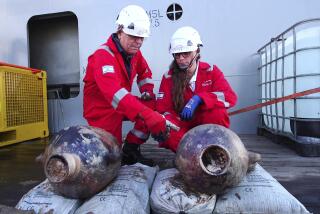Israeli Sub That Sank in ’68 Found
- Share via
JERUSALEM — Resolving one of the great mysteries of its country’s history, the Israeli navy confirmed Saturday that it has found the wreckage of the submarine Dakar, which vanished in 1968 with 69 sailors aboard.
The submarine was discovered resting on the floor of the Mediterranean Sea between Cyprus and Crete, near its original route from Britain to Israel, at a depth of nearly 10,000 feet, officials said.
“Today we are raising from the ocean’s depths the answer to a 31-year-old mystery,” army Chief of Staff Shaul Mofaz told a news conference Saturday.
A U.S. team hired by the navy to search for the submarine notified Israeli officials Friday that it had located a hulk on the seabed that appeared to be the Dakar. Confirmation was made Saturday by Israeli navy experts, who flew to the scene about 300 miles off the Israeli coast.
News of the discovery brings to an end an enduring national trauma for Israel, a small nation where almost everyone serves in the armed forces and where the loss or capture of even a single soldier provokes a collective outpouring of grief. It is the rare Israeli family that has not lost a member or at least a close friend in the armed services.
Navy Cmdr. Alex Tal, who had two friends among the Dakar’s officers, on Saturday thanked the U.S. Navy, which sent a submarine two years ago to assist in the decades-long search and had two representatives aboard the privately owned sub that made the discovery last week.
Tal also thanked the U.S. firm, Nauticus and its experts who used sophisticated sonar gear and robot-guided deep-sea photographic equipment to find the Dakar in one of the Mediterranean’s deepest spots.
Nurit Manor, whose husband, Dan, perished with the Dakar, said its discovery may finally allow her and the other families of the missing sailors to find emotional closure.
“I had one young child then, and my second son was born two months after the Dakar” disappeared, said Manor, who lives in Tel Aviv. “I went on with my life--it’s been so many years--but there was always an uncertainty.
“It’s difficult to say that I’m happy, but it’s very important for all of us that we know finally where it is. Now we have to think about what to do and whether to try to bring it out.”
Manor and many others believe that the submarine should be raised, so that authorities might be able to discover what happened and so families can be allowed to lay their loved ones to rest in Israel.
Manor and other family members of the sailors were scheduled to meet late Saturday in Haifa with Tal to receive a briefing about the discovery and discuss prospects for raising the submarine.
The vessel was first launched in 1943 and spent two decades in the British navy, as the Totem. It was purchased by Israel in 1965, underwent a lengthy refitting and, on Jan. 9, 1968, set out from Portsmouth to Haifa, its new home port.
About a week later, the Dakar stopped at Gibraltar for supplies. Its last contact with the shore command was Jan. 24, and it gave no indication of problems.
A series of searches by ships and planes from Israel, Britain, Greece, the United States, Turkey and even Lebanon turned up no trace of the sub. It was declared lost March 6, with all hands presumed dead.
Nearly a year later, one of its emergency beacons washed up on a Gaza Strip beach and was found by a Palestinian fisherman. Soil residues on the beacon and an evidently imperfect study of tides led to theories that the vessel might have sunk off the Egyptian coast.
After Israel and Egypt made peace in 1978, Egypt allowed the Israelis to search for the Dakar along its coastal waters, but no trace of the sub was found.
On Saturday, navy officials said that initial photographs showed a large hole in the Dakar’s hull but it was not yet possible to determine what caused it to sink.
But retired Rear Adm. Abraham Ben-Shoshan, who was commander of the Israeli navy from 1982 to 1985 and knew many who served on the Dakar, said most experts now believe the submarine sank due to human or technical error.
“Nobody ever knew what happened, but it was lost so soon after the 1967 war that the first thing we thought was that enemy activity destroyed it,” Ben-Shoshan said. “Now we will be able to find out what really happened.”
As the years of waiting dragged on, several family members of the victims criticized the Israeli government, saying that not enough had been done to try to find the submarine. The criticism tended to grow especially sharp around the anniversary of its loss, when relatives and navy officials gathered at Mt. Herzl national cemetery in Jerusalem to commemorate the victims.
“The families are entitled to say and feel anything they want. They paid the price, and no one should argue with them,” Ben-Shoshan said. “But [now] we can come to Mt. Herzl and tell them, after 31 years, we found it.”
More to Read
Sign up for Essential California
The most important California stories and recommendations in your inbox every morning.
You may occasionally receive promotional content from the Los Angeles Times.










